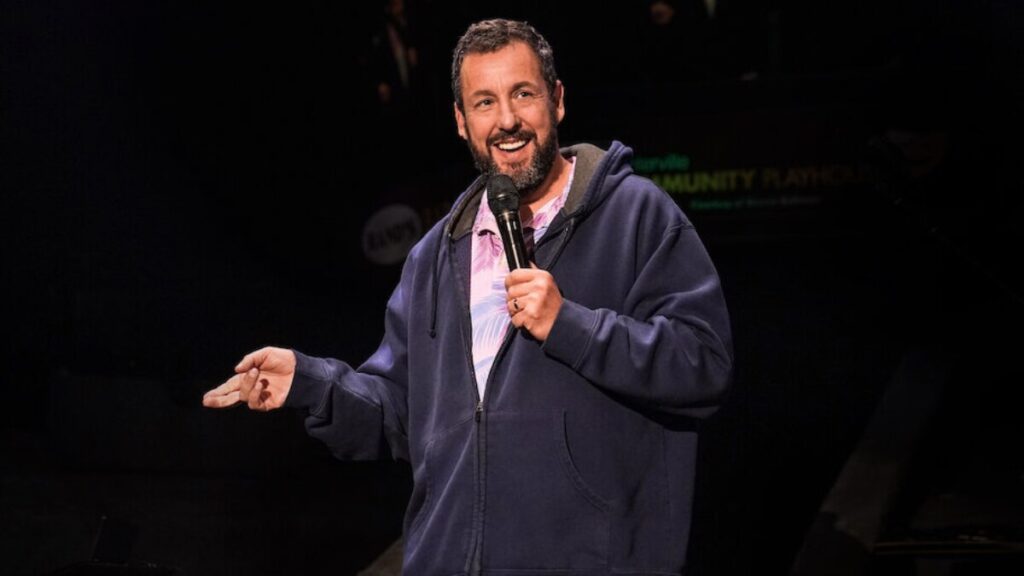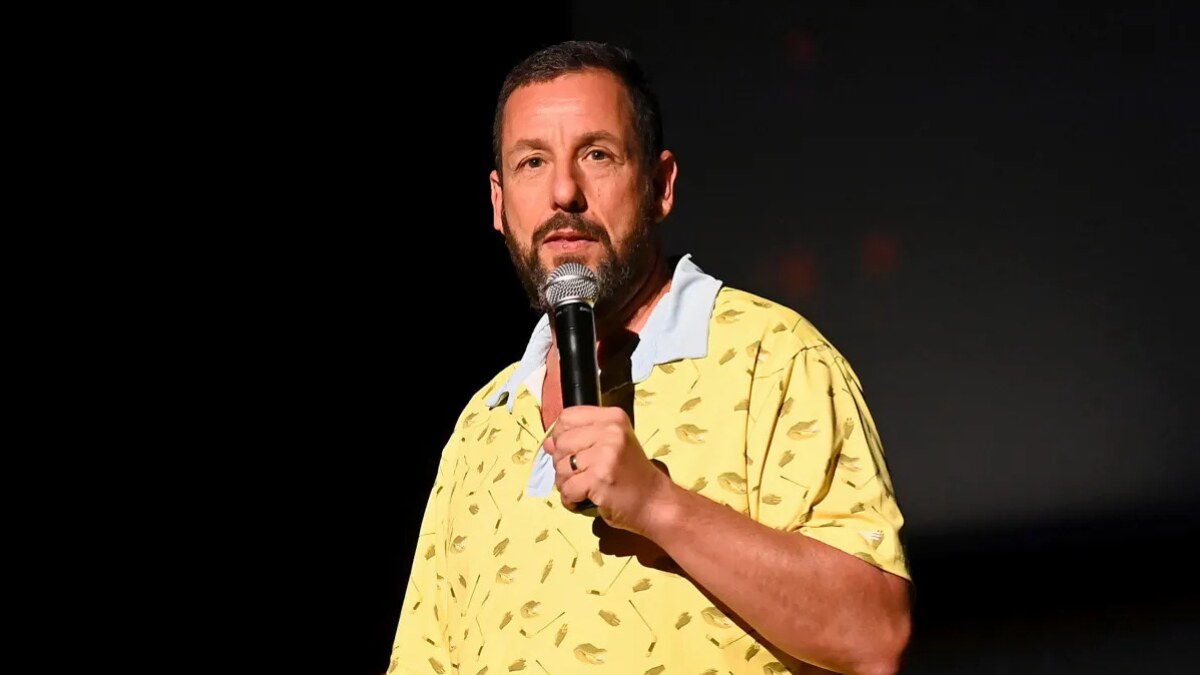There was a time—not long ago—when Adam Sandler’s name was shorthand for lazy comedy. Critics sharpened their knives, audiences rolled their eyes, and even fans seemed to accept that Sandler movies were something you put on while folding laundry, not something you chose to watch. Yet somehow, that same man—known for fart jokes and fake mustaches—has become one of the most powerful forces in streaming entertainment. He’s thriving.
How?
The answer isn’t just about Netflix deals or algorithmic luck. It’s about a reinvention that defies Hollywood norms. Sandler didn’t fade away or beg for prestige roles—he doubled down on what made him unique, then quietly broadened his range in a medium that welcomed him with open arms. He’s not chasing clout; he’s building an empire.
Sandler’s story matters because it challenges every assumption we make about career longevity, audience taste, and creative freedom. It’s not just a comeback—it’s a case study in how to win on your terms. And in today’s entertainment landscape, that might be the biggest plot twist of all.
Burned by the Box Office: When Sandler’s Magic Faded
By the early 2010s, Adam Sandler had become a victim of his success. Once a guaranteed draw with smash hits like Big Daddy and The Waterboy, his films began to feel more like obligations than events. Audiences showed up—sometimes reluctantly—but the joy was wearing thin. The formula hadn’t changed: goofy characters, a loyal ensemble cast, juvenile humor with a soft heart. But the culture had.
Movies like Jack and Jill (2011), where Sandler played both twins in a deeply panned farce, weren’t just box office misfires—they became cultural punching bags. That’s My Boy (2012) pushed the boundaries of taste so far that it lost even his core fanbase. And while Grown Ups 2 (2013) performed well financially, it was savaged critically, seen as a film coasting on name recognition and nostalgia.
There was a growing sense that Sandler was phoning it in—sometimes literally, as his scripts seemed designed around where he wanted to vacation. His comedic voice, once disruptive and fresh, now felt out of step with a post-Superbad, post-Bridesmaids comedy landscape that demanded sharper writing, more layered performances, and less reliance on pratfalls.
Critics weren’t just harsh—they were tired. And fans, once fiercely loyal, began to tune out. The problem wasn’t just that Sandler’s movies weren’t funny anymore; it was that they didn’t seem to care if they were.
This era highlighted a broader truth about Hollywood: star power alone no longer guaranteed success. Audiences, increasingly selective and spoiled by the rise of prestige TV and smarter comedies, expected more. Sandler’s name could still open a movie, but it couldn’t protect it from scrutiny—or fatigue.
He wasn’t canceled. He wasn’t even hated. He was just…fading. And in Hollywood, that’s often the most dangerous place to be.
Timeline Infobox: Sandler’s Theatrical Slide (2005–2015)
| Year | Film Title | Box Office (Worldwide) | Rotten Tomatoes Score | Audience Score |
|---|---|---|---|---|
| 2005 | The Longest Yard | $190M+ | 31% | 62% |
| 2006 | Click | $240M+ | 34% | 66% |
| 2007 | I Now Pronounce You Chuck & Larry | $186M | 14% | 51% |
| 2008 | You Don’t Mess with the Zohan | $204M | 37% | 45% |
| 2009 | Funny People | $71M | 69% | 48% |
| 2010 | Grown Ups | $271M+ | 10% | 62% |
| 2011 | Jack and Jill | $149M+ | 3% | 36% |
| 2012 | That’s My Boy | $57M | 20% | 46% |
| 2013 | Grown Ups 2 | $247M+ | 8% | 53% |
| 2014 | Blended | $128M | 15% | 55% |
| 2015 | Pixels | $244M | 18% | 46% |
The Netflix Pivot: How a Risky Deal Changed Everything
In 2014, when Adam Sandler signed a four-movie deal with Netflix, the announcement was met with confusion, if not outright mockery. Theatrical audiences were growing colder toward his films, and Netflix, at the time, was still testing the waters as a content studio. So why bet big on a star whose last few movies were box office punchlines?
Because Netflix wasn’t thinking like Hollywood.
While studios measured success in opening weekends and ticket sales, Netflix was chasing attention spans—and Sandler had those in spades. His movies, however critically reviled, were watchable. They were familiar, non-threatening, and easy to digest. In a landscape driven by autoplay and recommendation engines, that made him gold.
Netflix co-founder Ted Sarandos summed it up plainly: “People love Adam’s films. They watch them again and again.” And they did. The Ridiculous 6, Sandler’s first Netflix exclusive, was reportedly the most-watched film on the platform at the time of its release. Later, Murder Mystery—co-starring Jennifer Aniston—amassed over 73 million views in its first month. That’s blockbuster territory without a single box office ticket sold.
For Sandler, the move was liberating. Gone were the pressures of critics, box office projections, or theatrical marketing. In their place: creative control, relaxed production schedules, and an open runway to make the kind of movies he wanted, with the people he liked. The Happy Madison sandbox suddenly had a global audience of 190+ countries.
Importantly, this pivot wasn’t just about reach—it was about relevance. While many aging stars were scrambling to reinvent themselves through prestige projects or late-career seriousness, Sandler leaned into his brand. Streaming gave him space to evolve without losing his essence.
And he wasn’t just surviving—he was dominating. In 2020, Netflix extended the deal, citing “unprecedented popularity.” The platform knew what traditional Hollywood had missed: Sandler wasn’t a fluke—he was a fixture. A personality who didn’t need to change his game, just his venue.
In bypassing the theater, Sandler didn’t step down—he leveled up. And in doing so, he helped Netflix prove that star power could thrive in pixels, not just popcorn.
Comedy in Joggers: The Sandler Production Philosophy
Step onto an Adam Sandler set, and you’re likely to find a vibe closer to a weekend getaway than a pressure-cooked film shoot. That’s by design. Through Happy Madison’s role in Sandler’s streaming empire, Sandler has created not just a production company but a creative sanctuary—one built on comfort, camaraderie, and a deeply personal kind of loyalty.
Yes, he casts his friends. And yes, many of the jokes feel like inside jokes. But that’s the point.
Since its founding in 1999, Happy Madison has become a recurring cast of characters: Rob Schneider, Kevin James, Steve Buscemi, and David Spade. For critics, it’s often dismissed as lazy filmmaking. But to Sandler, it’s a chosen family. On set, everyone knows their role, everyone’s in on the rhythm, and above all, everyone’s having fun.
There’s something undeniably human about this ecosystem. It may not always result in high art, but it exudes a kind of behind-the-scenes authenticity that translates surprisingly well on screen—especially in the era of streaming. These aren’t movies begging for theatrical reverence. They’re comfort content, perfectly suited for sweatpants and late-night scrolling.
That DIY, blue-collar energy—shoot in Maui, cast your buddies, crack some beers—is part of what makes Sandler’s Netflix era resonate. It feels like a peek into a world where the stakes are low, the laughs are frequent, and the goal isn’t perfection—it’s presence.
Critics may groan, but millions press play. Maybe it’s because, on some level, we recognize that joy—real joy—is hard to fake. And Sandler, surrounded by his crew, in cargo shorts and Crocs, doesn’t fake a thing.
Rewriting the Rules of Stardom in the Age of Algorithms
In the age of infinite scroll, Adam Sandler isn’t just a movie star—he’s an algorithmic asset. His films don’t need opening weekends or critical acclaim; they need clicks, replays, and retention. And they deliver. Again, and again.
Sandler has become the human equivalent of the “You might also like” suggestion: familiar, frictionless, endlessly rewatchable. His comedies aren’t just accessible—they’re engineered (intentionally or not) for a world where audiences want to half-watch while folding laundry, laugh without effort, and re-enter a scene without needing context. In short, his movies stream well.
Netflix doesn’t necessarily care if viewers finish every minute—they care if viewers stay on the platform. And Sandler’s catalog, full of gentle chaos and predictable laughs, offers a kind of ambient entertainment that fits the bill. Think of him as the digital-era version of cable TV comfort: always there, always easy, never demanding.
This isn’t to say Sandler gamed the system—but he understood it. He didn’t chase the prestige arc or reinvent himself as an auteur. Instead, he leaned into what he does best and trusted that audiences—and algorithms—would find him.
Compare that to other stars of his era. Jim Carrey veered into prestige and political commentary. Will Ferrell struggled to find a footing outside his early-2000s persona. Even Ben Stiller, now acclaimed as a director, stepped away from acting. Sandler stayed in the frame, jogging shorts and all, and simply shifted venues.
In the streaming economy, attention is currency. Sandler isn’t just earning it—he’s recycling it. His genius isn’t reinvention; it’s recalibration. He figured out what digital audiences crave: something comforting, familiar, and just chaotic enough to keep you from switching apps.
From Punchlines to Prestige: The Surprising Return of Serious Sandler
When Uncut Gems dropped in 2019, the reaction wasn’t just surprise—it was disbelief. Adam Sandler? That’s Adam Sandler? Suddenly, the man best known for yelling in silly voices was pacing through a high-stakes psychological thriller, playing Howard Ratner, a diamond dealer in freefall. The performance was electric, exhausting, and—for many—revelatory.

But here’s the thing: this wasn’t Sandler’s first attempt at drama. Earlier efforts like Spanglish (2004) and Reign Over Me (2007) hinted at emotional depth, but never quite landed. Those films lacked urgency, direction, or perhaps just the right director to mine what was underneath the surface. Enter the Safdie Brothers—filmmakers who thrive in chaos. Their frenetic style paired perfectly with Sandler’s latent edge, revealing a version of him we hadn’t seen: raw, desperate, utterly watchable.
Critics, long Sandler’s harshest skeptics, took notice. The New York Times called his Uncut Gems performance “career-defining,” while audiences—many discovering the film via Netflix—couldn’t stop buzzing. It wasn’t a fluke. In 2022’s Hustle, Sandler once again flexed his dramatic muscles, playing a weary basketball scout with grounded humanity. While less bombastic, it showcased restraint and sincerity—two qualities rarely associated with his earlier work.
Streaming played a crucial role in this transformation. Unlike theaters, where audiences choose a film with purpose, platforms like Netflix enable surprise. A skeptical viewer might click Uncut Gems out of curiosity—only to stay transfixed. The same Sandler who was once background noise had suddenly become appointment viewing.
And perhaps that’s his greatest trick of all. He didn’t shed his old self to chase respectability. He simply showed that it had always been there—beneath the jokes, the accents, the cargo shorts. The industry just had to take a second look. And this time, it did.
Comparison Table: Two Faces of Sandler
| Film Title | Genre | Platform | Rotten Tomatoes Score | Audience Score | Streaming Stats (if known) | Awards / Nominations |
|---|---|---|---|---|---|---|
| Uncut Gems (2019) | Drama | Netflix / A24 | 92% | 52% | Top 10 on Netflix globally | Independent Spirit Award – Best Male Lead |
| Hustle (2022) | Drama | Netflix | 93% | 93% | Top 10 in 92 countries (Netflix) | SAG Award Nomination, critical praise |
| Reign Over Me (2007) | Drama | Theatrical | 64% | 81% | N/A | Mixed reviews; no major nominations |
| Punch-Drunk Love (2002) | Drama / Dark Comedy | Theatrical | 79% | 77% | N/A | Golden Globe nomination – Best Actor |
| Happy Gilmore (1996) | Comedy | Theatrical | 61% | 85% | N/A | Cult classic; pop culture icon |
| The Ridiculous 6 (2015) | Comedy | Netflix | 0% | 34% | Netflix’s “most-watched” at release | No nominations; widely panned |
| Murder Mystery (2019) | Comedy | Netflix | 44% | 61% | 73M+ households in first 4 weeks | Netflix Top 10 (2019) |
| Grown Ups (2010) | Comedy | Theatrical | 10% | 62% | $271M worldwide | No nominations; high box office returns |
| Jack and Jill (2011) | Comedy | Theatrical | 3% | 36% | $149M worldwide | Swept the Razzies |
How Sandler’s Second Act Compares to Hollywood’s A-List Pivots
Adam Sandler isn’t the only comedy titan to face the mid-career crossroads. He’s part of a generational class—Jim Carrey, Will Ferrell, Ben Stiller, Eddie Murphy—who all once defined studio comedy and later had to confront a sobering truth: audiences change. And so must the stars.
Jim Carrey veered into prestige early, earning praise for The Truman Show and Eternal Sunshine of the Spotless Mind, but retreated from Hollywood in recent years, dipping into political art and selective roles. Ferrell, once on top with Anchorman and Step Brothers, has struggled to find post-2010 hits, often caught between staying goofy and striving for depth. Ben Stiller arguably made the cleanest pivot—moving behind the camera to direct acclaimed series like Severance. Eddie Murphy made a celebrated return with Dolemite Is My Name, but hasn’t fully reclaimed consistent momentum.
Sandler’s second act stands apart for one key reason: he never fully abandoned his roots, nor did he cling to them too tightly. Instead of chasing prestige at the expense of his brand, he found a way to layer his identity—continuing to make broad comedies with Happy Madison while simultaneously delivering prestige performances like Uncut Gems. He straddles two worlds, without apology.
And unlike his peers, Sandler wasn’t afraid to lean into streaming before it was cool. Where others hesitated, he signed a deal that gave him creative freedom and a direct line to the next generation of viewers.
The result? Sandler didn’t just reinvent himself—he redefined what reinvention could look like. His career is now a blueprint for staying culturally relevant without losing your comedic soul.
Comparison Table: Four Icons, Four Very Different Second Acts
| Actor | Streaming Strategy | Signature Streaming Projects | Prestige Shift / Dramatic Turn | Dolemite re-established a dramatic/comedic blend | Audience Loyalty / Brand Strength |
|---|---|---|---|---|---|
| Adam Sandler | Early, aggressive Netflix pivot (2014); multi-picture exclusive deals | Murder Mystery, The Ridiculous 6, Hustle, Leo | Uncut Gems, Hustle – acclaimed dramatic roles | Uncut Gems (92% RT), Hustle (93% RT) | High: Maintains comedic identity while adding range |
| Jim Carrey | Limited streaming presence; focus on selective prestige roles | Kidding (Showtime), Sonic the Hedgehog (Paramount+ release) | Strong history with prestige (Eternal Sunshine, Truman Show) | Kidding (Showtime – praised, canceled early) | Moderate: Public image fragmented; less frequent output |
| Will Ferrell | Late and inconsistent adoption; some streaming comedies via Amazon, Netflix | Eurovision Song Contest, Spirited | Few serious roles; mostly comedic pivots | Spirited (69% RT), Eurovision (63%) | Declining: Brand fatigue and hit-or-miss returns |
| Eddie Murphy | Resurgence through strategic Netflix and Amazon partnerships | Dolemite Is My Name, Coming 2 America | Strong history with prestige (Eternal Sunshine, The Truman Show) | Dolemite Is My Name (97% RT) | Medium-High: Respected return, but not yet sustained |
Why I (Reluctantly) Admire Streaming Sandler
I didn’t set out to like Adam Sandler. For years, I rolled my eyes at every new trailer—another slapstick comedy, another all-expenses-paid vacation disguised as a film. I grew up on Billy Madison and Happy Gilmore, sure, but somewhere along the way, the charm wore off. Sandler became shorthand for “phoning it in.”
Then, one lazy Sunday, Murder Mystery popped up on Netflix. I clicked it almost out of spite—expecting background noise, maybe a few half-hearted chuckles. But somewhere between the bad accents and the yacht explosions, I found myself… smiling. Not ironically. Genuinely. It was silly and safe and, weirdly, exactly what I needed.
But it was Uncut Gems that cracked me open. I remember sitting frozen as the credits rolled, pulse still racing. I’d never seen Sandler like that—sharp, tortured, magnetic. It wasn’t a fluke. Hustle came next, and suddenly, the man I’d mentally filed under “guilty pleasure” was delivering nuanced, human performances with restraint and depth.
That shift—both mine and his—feels symbolic. Sandler didn’t beg for respect; he earned it on his terms. And I, like so many others, had to admit I’d underestimated him.
Now, when his name pops up in my Netflix queue, I don’t groan. I click. Maybe that’s not just good PR. Maybe it’s the rarest thing in entertainment: a second act that works.
The Legacy Equation: What Will Sandler Be Remembered For?
Adam Sandler’s legacy isn’t easy to pin down—and that might be exactly the point. Is he the goofball with the weird voices and the juvenile humor? Yes. Is he the high-stakes dramatic actor who stunned critics in Uncut Gems? Also yes. A family man in basketball shorts, a multimillionaire with global reach, a frequent Razzie nominee who just might end up with an Oscar? Somehow, all of it fits.
What’s remarkable about Sandler isn’t just the span of his career—it’s the fact that he never seemed desperate to evolve. He didn’t stage a dramatic rebranding or plead for critical redemption. He simply kept working, kept experimenting, and let the audience come to him on their terms. And they did.
He’s been mocked mercilessly, memed relentlessly, and underestimated consistently. Yet when you zoom out, the portrait becomes clear: a comedian who outlasted trends, a producer who built a creative haven, and a streaming juggernaut who reshaped modern stardom without abandoning who he was.
Sandler’s legacy, then, is less about reinvention than resilience. He didn’t change to fit the times—he waited until the times fit him. In doing so, he expanded the definition of Hollywood success itself: not just box office or awards, but longevity, loyalty, and the ability to surprise us—over and over again.
And maybe, just maybe, that’s what greatness looks like in the 21st century.
Mohit Wagh is the co-founder of The Graval with over 10 years of experience in SEO and content strategy. He specializes in crafting data-driven, authoritative content that blends cultural insight with digital growth.





6 thoughts on “Adam Sandler’s Second Act: From Box Office Burnout to Streaming Supremacy”